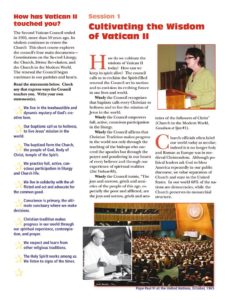The Second Vatican Council affirmed life in the parish I grew up in—St. Donatus, Brooten, MN. Our pastor from the time I was 12 involved the 55 families in the liturgical movement and the justice that Dorothy Day and Peter Maurin advocated in the Catholic Worker. Dorothy Day came to our parish and spoke when I was a sophomore.
In our parish the Eucharist was the Church’s greatest prayer, piety was best expressed in daily Mass, and a scripture passage was a common penance. A simple altar table replaced the plaster wedding-cake altar. Our Madonna and child were handcarved in oak and polychromed. The Easter Vigil required full, active, conscious participation of almost all of us; we loved moving out of church and back in with candles. Young married couples participated in CFM conversations. I did my first college research paper on the new St. John’s Abbey Church, a creative, poured-concrete, semi-circular Church where Father Geoffrey Diekmann and other Benedictine monks worshiped and put into practice what their magazine Worship taught about liturgical renewal.

As a child of the 1960s, I experienced change and progress in both church and country. The liturgical movement came to fruition for the whole Church when the Second Vatican Council passed its first document, which was on the Sacred Liturgy (1963). It turned altars around and gave us worship in the vernacular. The Civil Rights Movement came to fruition in the Civil Rights Act of 1965. In its final session that same year the Council brought the Church into the modern world with Gaudium et Spes, the most complete articulation of Catholic social teaching and human rights (1965). I made first vows that year, having been formed on these documents, ready for the second wave of feminism that arose with the ERA and anti-war protests that grew fierce by 1968.
Vatican II is an experience of the Holy Spirit I work to keep alive.